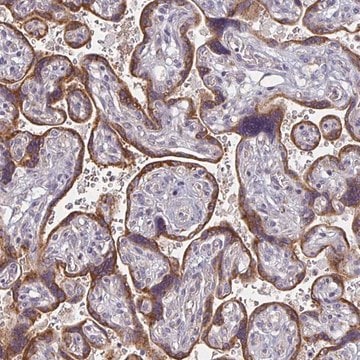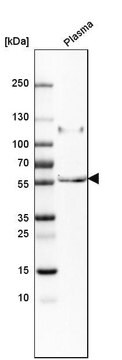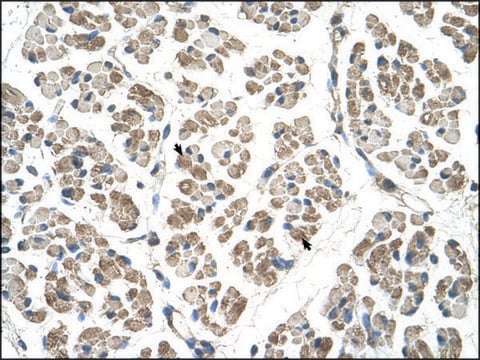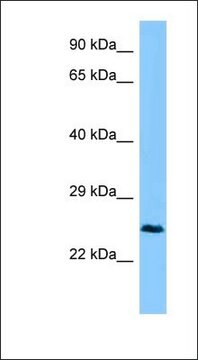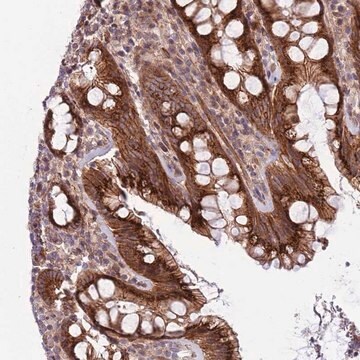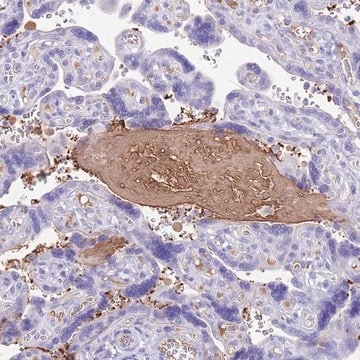MABT889
Anti-CTHRC1 Antibody, clone Vli-55
clone Vli-55, from rabbit
Synonim(y):
Collagen triple helix repeat-containing protein 1, Protein NMTC1
About This Item
Polecane produkty
pochodzenie biologiczne
rabbit
Poziom jakości
forma przeciwciała
purified antibody
rodzaj przeciwciała
primary antibodies
klon
Vli-55, monoclonal
reaktywność gatunkowa
rat, mouse, human, porcine
metody
immunohistochemistry: suitable
western blot: suitable
numer dostępu NCBI
numer dostępu UniProt
Warunki transportu
wet ice
docelowa modyfikacja potranslacyjna
unmodified
informacje o genach
mouse ... Cthrc1(68588)
Opis ogólny
Specyficzność
Immunogen
Zastosowanie
Western Blotting Analysis: Representative lots detected exogenously expressed human and rat CTHRC1 in lysates from transfected cells (Duarte, C.W., et al. (2014). PLoS One.;9(6):e100449; Stohn, J.P., et al. (2012). PLoS One. 7(10):e47142).
Western Blotting Analysis: A representative lot detected the overexpressed Cthrc1 in plasma samples from Cthrc1 trangenic mice, as well as immunoprecipitated CTHRC1 from normal human plasma samples (Stohn, J.P., et al. (2012). PLoS One. 7(10):e47142).
Immunohistochemistry Analysis: A representative lot detected increased Cthrc1 expression in interstitial cells and activated fibroblasts of various remodeling tissues from wild-type, but not Cthrc1-null mice following angiotensin II infusion by immunohistochemistry staining of paraformaldehyde-fixed, paraffin-embedded sections (Duarte, C.W., et al. (2014). PLoS One.;9(6):e100449).
Immunohistochemistry Analysis: Representative lots immunostained Cthrc1-positive cells in paraformaldehyde-fixed, paraffin-embedded human, pig, and rat pituitary gland tissue sections (Duarte, C.W., et al. (2014). PLoS One.;9(6):e100449; Stohn, J.P., et al. (2012). PLoS One. 7(10):e47142).
Immunohistochemistry Analysis: A representative lot immunostained adventitial cells of remodeling renal artery, dermal cells in skin wounds, embryonic cartilage, as well as midbrain of wild-type, but not Cthrc1-null mice, using paraformaldehyde-fixed, paraffin-embedded tissue sections (Stohn, J.P., et al. (2012). PLoS One. 7(10):e47142).
Immunohistochemistry Analysis: A representative lot localized Cthrc1 immunoreactivity in various regions of paraformaldehyde-fixed, paraffin-embedded mouse and pig brain sections (Stohn, J.P., et al. (2012). PLoS One. 7(10):e47142).
Cell Structure
Adhesion (CAMs)
Jakość
Western Blotting Analysis: 10 µg/mL of this antibody detected CTHRC1 in 10 µg of human brain tissue lysate.
Opis wartości docelowych
Postać fizyczna
Przechowywanie i stabilność
Inne uwagi
Oświadczenie o zrzeczeniu się odpowiedzialności
Not finding the right product?
Try our Narzędzie selektora produktów.
Kod klasy składowania
12 - Non Combustible Liquids
Klasa zagrożenia wodnego (WGK)
WGK 1
Temperatura zapłonu (°F)
Not applicable
Temperatura zapłonu (°C)
Not applicable
Certyfikaty analizy (CoA)
Poszukaj Certyfikaty analizy (CoA), wpisując numer partii/serii produktów. Numery serii i partii można znaleźć na etykiecie produktu po słowach „seria” lub „partia”.
Masz już ten produkt?
Dokumenty związane z niedawno zakupionymi produktami zostały zamieszczone w Bibliotece dokumentów.
Nasz zespół naukowców ma doświadczenie we wszystkich obszarach badań, w tym w naukach przyrodniczych, materiałoznawstwie, syntezie chemicznej, chromatografii, analityce i wielu innych dziedzinach.
Skontaktuj się z zespołem ds. pomocy technicznej